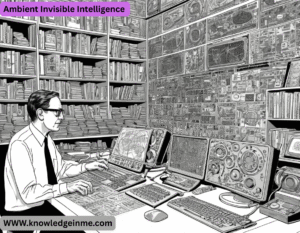Ambient Invisible Intelligence Ambient Invisible Intelligence (AII) refers to smart, context-aware systems that operate seamlessly in the background, enhancing human experiences without requiring direct interaction. These systems leverage AI, IoT, sensors, and ambient computing to anticipate needs, automate tasks, and adapt environments—all while remaining unobtrusive.
Key Features of AII:
- Unobtrusive Presence – Works silently in the background without screens or overt interfaces.
- Context-Awareness – Uses sensors, location data, and behavioral patterns to understand user needs.
- Proactive Automation – Anticipates actions (e.g., adjusting lighting, temperature, or notifications).
- Ambient Computing – Integrates with surroundings (smart homes, wearables, urban infrastructure).
- Privacy-Centric – Operates with minimal data exposure, often using edge AI for local processing.
Examples of AII in Action:
- Healthcare – Wearables monitor vitals and alert caregivers if anomalies arise.
- Retail & Workspaces – AI-driven environments personalize lighting, sound, and displays.
- Urban Spaces – Traffic systems optimize flow without human input.
Challenges:
- Privacy & Trust – Balancing convenience with data security.
- Ethical AI – Avoiding bias in decision-making.
- Seamless Integration – Ensuring interoperability across devices.
Core Principles of AII
- AII is built on several foundational concepts:
Unobtrusiveness
- Unlike traditional interfaces (phones, screens, voice assistants), AII operates passively.
- Example: A smart thermostat learns your schedule and adjusts temperatures without prompts.
Contextual Awareness
- Uses sensors (motion, biometrics, environment), historical data, and predictive AI to infer intent.
- Example: A smart office dims lights when it detects you’re in a video call.
Autonomy & Proactivity
- Takes actions before the user realizes the need.
- Example: A car pre-cooling its interior before your commute based on calendar events.
Ambient Computing
- Distributes intelligence across devices (IoT, edge computing) rather than relying on a central hub.
- Example: Wearables, smart speakers, and home sensors working together silently.
2. Key Technologies Enabling AII
Technology Role in AII Example Use Case
AI/ML (TINYML, Federated Learning) Enables adaptive, personalized decision-making Smart fridge predicting grocery needs
IoT & Edge Computing Processes data locally for real-time responses Motion sensors adjusting lighting
Ambient Sensors (LiDAR, Thermal, Radar) Detects presence, activity, and environment Sleep monitors adjusting room temperature
5G & Low-Power Networks (Wi-Fi 6, LORAWAN) Ensures seamless connectivity Smart city traffic optimization
Augmented Reality (AR) HUDs Overlays subtle digital cues in real-world view Navigation hints in smart glasses
3. Real-World Applications
Smart Homes & Workspaces
- Adaptive Lighting & Climate: Systems like Google Nest learn routines and adjust automatically.
- Predictive Maintenance: AI detects appliance wear-and-tear before failures occur.
b) Healthcare & Wellbeing
- Elderly Care: Ambient sensors detect falls or irregular activity patterns.
- Mental Health Monitoring: Voice tone analysis in smart speakers detects stress.
Retail & Hospitality
- Invisible Checkout: Amazon Go stores use AII for cashier-less shopping.
Smart Cities & Mobility
- Traffic Flow Optimization: AI adjusts signals in real time to reduce congestion.
- Autonomous Public Transport: Self-driving shuttles adapt routes based on demand.
4. Ethical & Societal Challenges
Privacy Concerns
- Always-On Sensors: Risk of covert surveillance (e.g., smart TVs listening unintentionally).
- Data Ownership: Who controls the behavioral data collected by AII systems?
Algorithmic Bias
If AII learns from biased data, it may reinforce discrimination (e.g., favoring certain user demographics).
Over-Automation & Human Agency
- Could AII make people too reliant on automation, reducing critical thinking?
Environmental Impact
- Billions of IoT devices increase e-waste and energy consumption—sustainable design is crucial.
5. The Future of AII
Merging with Brain-Computer Interfaces (BCIs)
- Future AII may read neural signals to anticipate needs before conscious thought (e.g., Elon Musk’s NNEURALINK).
Self-Healing Environments
- Buildings that repair minor damages (e.g., self-sealing windows) using embedded AI.
Emotionally Intelligent AII
- Systems that detect and respond to human emotions (e.g., calming lighting during stress).
Regulatory Frameworks
- Governments may enforce “Right to Invisibility” laws, allowing users to opt out of AII tracking.
- Neuroscience & AII: The Brain-Computer Symbiosis
Passive Brainwave Monitoring
- EEG-Integrated Environments: Future AII could use non-invasive sensors (e.g., in headrests, pillows) to detect stress/focus levels via brainwaves.
- Example: An office that dims distractions when it senses cognitive overload.
- Predictive Mental Healthcare: AI analyzes micro-changes in behavior (keystrokes, gait) to flag depression before self-awareness.
“Pre-Cognitive” AII
- Research in predictive neural modeling aims to anticipate actions before conscious intent.
- MIT’s “AlterEgo”: A wearable that reads subvocalizations (internal speech) to trigger actions silently.
- Ethical Dilemma: Should AII act on impulses you haven’t consciously approved?
7. The Dark Side: Security & Exploitation Risks
“Invisible Hacking”
- Side-Channel Attacks: Hackers exploit ambient sensors (e.g., smart thermostats detecting keyboard vibrations to steal passwords).
- AI Poisoning: Manipulating sensor data to trick AII (e.g., fooling a self-driving car with adversarial street art).
Surveillance Capitalism 2.0
- Corporations could monetize ambient behavioral data (e.g., insurance premiums adjusted based on sleep patterns caught by smart mirrors).
- China’s Social Credit System: AII could automate punitive measures (e.g., restricting travel if sensors detect “undesirable” behavior).
Psychological Manipulation
- Subliminal Nudging: AII could exploit dopamine-driven feedback loops (e.g., smart lighting in stores subconsciously guiding purchases).
- The “Filter Bubble” Extreme: Environments that reinforce biases by only showing ideologically aligned content.
8. Philosophical & Existential Questions
The “Invisible Hand” of AI
If AII silently shapes decisions, do humans retain free will—or become “puppets of algorithms”?
- Thought Experiment: A smart home that discourages unhealthy snacks by making fridge lights dim near junk food.
The Loss of Serendipity
- Over-optimized environments may eliminate chance encounters (e.g., AI-routed paths preventing “useless” walks where creativity sparks).
9. Speculative Future: AII in 2050
Self-Assembling Spaces
- Programmable Matter: Rooms where furniture reconfigures via nanotech (e.g., walls becoming desks on command).
- Bio-Integrated AII: Genetically modified plants acting as living sensors (e.g., algae that glow when air quality drops).
AII as a Global “Nervous System”
- Planetary-Scale Sensing: Millions of drones/satellites creating a real-time “digital twin” of Earth for climate AII.
Post-Human Environments
- AII for Non-Humans: Zoos where AI adjusts habitats in real-time based on animal stress signals.
- AI “Gardening” Ecosystems: Autonomous drones rewilding forests by planting species optimized by climate AI.
10. Building Ethical AII: A Proposed Framework
Principle Implementation
User Sovereignty Mandatory “ambient off-switches” and data veto rights (e.g., GDPR for AII).
Algorithmic Transparency Public audits of AII decision-making (e.g., Why did my lights dim at 3PM?).
Ecological Design AII devices must be biodegradable/solar-powered (e.g., fungal-based sensors).
Final Reflection: Utopia or Dystopia?
AII could lead to:
- Utopia: A world where technology eliminates friction, letting humans focus on creativity and connection.
- Dystopia: A panopticon where freedom erodes under invisible algorithmic control.






